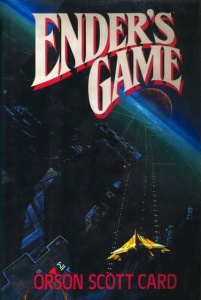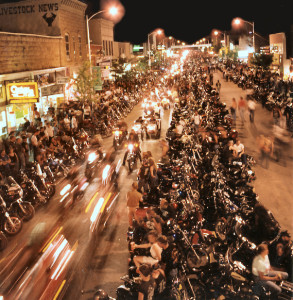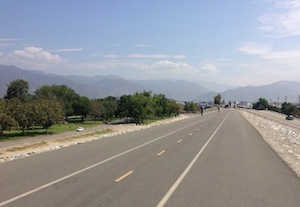 It’s Saturday morning, and I drop onto (ride down to from a street) the San Gabriel River Bike Trail. In the distance, about 20 miles (32 km) away, the San Gabriel Mountains hide behind southern California’s summer haze (dust, moisture in the air). I hope to be there in a little more than an hour.
It’s Saturday morning, and I drop onto (ride down to from a street) the San Gabriel River Bike Trail. In the distance, about 20 miles (32 km) away, the San Gabriel Mountains hide behind southern California’s summer haze (dust, moisture in the air). I hope to be there in a little more than an hour.
I settle into (get comfortable in) my saddle (bicycle seat) and start slowly to warm up (prepare for more effort). Before long I’m riding at a comfortable 15-18 miles per hour (24-29 kmh).
Soon the trail crosses over to the other side of the river. It’s newer here, and smoother, like a freeway for bicycles. I pass the Pico Rivera golf course, circle (move in a circle) the end of the course, then stand on the bike pedals to climb to the top of the Whittier Narrows Dam (a wall across the river to stop the water).
Past the dam, the trail drops again as it continues toward the mountains. There’s not much to see here – backyards, weekend soccer games at two or three schools, and a small farm and stable (a place where horses are kept). The horses are too busy eating to notice me, but the roosters (male chickens) crow (make the sound of a rooster) as I speed by.
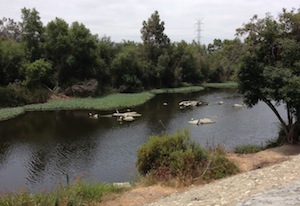 The trail dips (goes down, then up again) under the 60 Freeway and takes me to one of the scenic (beautiful) parts of the ride – the one portion (part) of the river that has water this time of the year. Trees and water plants line (grow along) the river, and ducks and heron enjoy the water. The humming (sound like “hmmm”) of my bike’s tires and the wind in my ears are the only sounds I hear.
The trail dips (goes down, then up again) under the 60 Freeway and takes me to one of the scenic (beautiful) parts of the ride – the one portion (part) of the river that has water this time of the year. Trees and water plants line (grow along) the river, and ducks and heron enjoy the water. The humming (sound like “hmmm”) of my bike’s tires and the wind in my ears are the only sounds I hear.
There’s little traffic (other bikes) on the trail today – an occasional single rider like me and fathers with their children. Two or three pace lines (cyclists who ride in a line to help each other push through the wind) of weekend warriors (very serious riders) come from the opposite direction on their way to the ocean.
The trail dips under the 10 Freeway and carries me through an industrial area to the base (bottom) of the Santa Fe Dam – nothing to see here except an occasional ground squirrel scurrying (moving quickly) across the trail. The trail to the top of the Dam is steep (rises quickly) and long, and I have to stand on my pedals to produce enough power to get there. By the time I reach the top, my calves (back of the leg below the knee) burn (feel hot) from the effort.
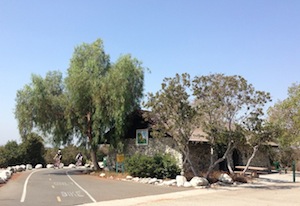 At the top of the dam, the trail circles the Santa Fe Recreation Area, a lake surrounded by trees and picnic tables, before taking me through the Santa Fe Nature Center. Here the trail winds (twists and turns) through a large garden filled with native plants and walking trails. I continue up the trail into the mountains, dipping under one more freeway, until I reach the end of the trail.
At the top of the dam, the trail circles the Santa Fe Recreation Area, a lake surrounded by trees and picnic tables, before taking me through the Santa Fe Nature Center. Here the trail winds (twists and turns) through a large garden filled with native plants and walking trails. I continue up the trail into the mountains, dipping under one more freeway, until I reach the end of the trail.
I’m in trouble! I chat with other riders for a few minutes, but when I leave to begin the return trip (go to where I started), I discover that the wind has come up (started blowing harder). I will have to spend the next hour-and-a-half riding into the wind! Not a pleasant thought.
The first few miles are down-hill. That helps. And the trees at the Nature Center protect me for a while, but when I reach the top of the dam, gusts of wind (sudden strong winds) from the side make it difficult to stay on the trail. When the trail turns into the wind, another rider and I take turns drafting (riding very close behind so the front rider protects the back rider from the wind) until the trail drops back down to the riverbed.
Ten miles to go. The wind continues to blow and the temperature rises (gets hotter). My legs feel heavy, and my speed slowly drops (decreases). This time, when the roosters crow, I’m not sure if they’re encouraging me or laughing at me.
I make it (get to where I’m going), tired and hot. But I’ll be back, probably next week, to do it again. Happily.
~ Warren Ediger – English tutor/coach and creator of Successful English, where you’ll find clear explanations and practical suggestions for better English.
Photos by W. Ediger






